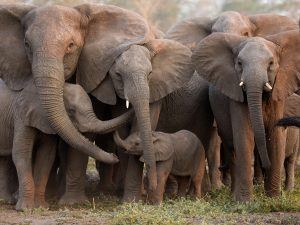Natalie Angier in The New York Times:
 GORONGOSA NATIONAL PARK, Mozambique — We are flying in a Bat Hawk aircraft — which may be named for a raptor that preys on bats but looks more like a giant, lime-green dragonfly — and my hair, thanks to the open cockpit, has gone full Phyllis Diller. Scudding above flood plains the color of worn pool table felt and mud flats split like jigsaw puzzles, we dip toward the treetops and see herds of waterbuck scatter with an impatient flash of their bull’s-eye rumps. We are searching for the elusive tuskless elephants of Gorongosa, elephants that naturally lack the magnificent ivory staffs all too tragically coveted by wealthy collectors worldwide. Tuskless elephants can be found in small numbers throughout Africa, but Gorongosa is known to harbor a sizable population of them, the legacy of a violent 15-year civil war. Tusked elephants were slaughtered for their ivory at a harrowing rate, and the park’s rare tusk-free residents thus gained a sudden Darwinian advantage. Today, about a quarter of the park’s 700 or so elephants are tuskless, all of them female, and I am determined to catch a glimpse of at least one. Yet a week of ground searches has proved fruitless, and now we are circling in a plane and still nothing and, holy mother of Horton, how can such massive creatures go missing?
GORONGOSA NATIONAL PARK, Mozambique — We are flying in a Bat Hawk aircraft — which may be named for a raptor that preys on bats but looks more like a giant, lime-green dragonfly — and my hair, thanks to the open cockpit, has gone full Phyllis Diller. Scudding above flood plains the color of worn pool table felt and mud flats split like jigsaw puzzles, we dip toward the treetops and see herds of waterbuck scatter with an impatient flash of their bull’s-eye rumps. We are searching for the elusive tuskless elephants of Gorongosa, elephants that naturally lack the magnificent ivory staffs all too tragically coveted by wealthy collectors worldwide. Tuskless elephants can be found in small numbers throughout Africa, but Gorongosa is known to harbor a sizable population of them, the legacy of a violent 15-year civil war. Tusked elephants were slaughtered for their ivory at a harrowing rate, and the park’s rare tusk-free residents thus gained a sudden Darwinian advantage. Today, about a quarter of the park’s 700 or so elephants are tuskless, all of them female, and I am determined to catch a glimpse of at least one. Yet a week of ground searches has proved fruitless, and now we are circling in a plane and still nothing and, holy mother of Horton, how can such massive creatures go missing?
“There!” Alfredo Matavele, the pilot, cries triumphantly, pointing toward a cluster of trees. “And there!” pointing toward a watering hole. And there and there. “Do you see them?” he demands. Oh yes, I see them. Dozens, scores, cliques and claques of elephants, ears flapping like flags, trunks slowly swinging, and many of their faces decidedly free of ivory eruptions. I have found them at last, my sisters in dental deprivation. Other people may admire elephants for their brains or their complex social lives; I feel a bond with this mutant crew. After all, I’ve learned that we share a basic developmental anomaly, which may well be traceable to the same underlying glitches in our DNA. Elephant tusks happen to be overgrown versions of the upper lateral incisors — the teeth right next to the front teeth, before you get to the canines. Simply put, tuskless elephants lack lateral incisors.
More here.
